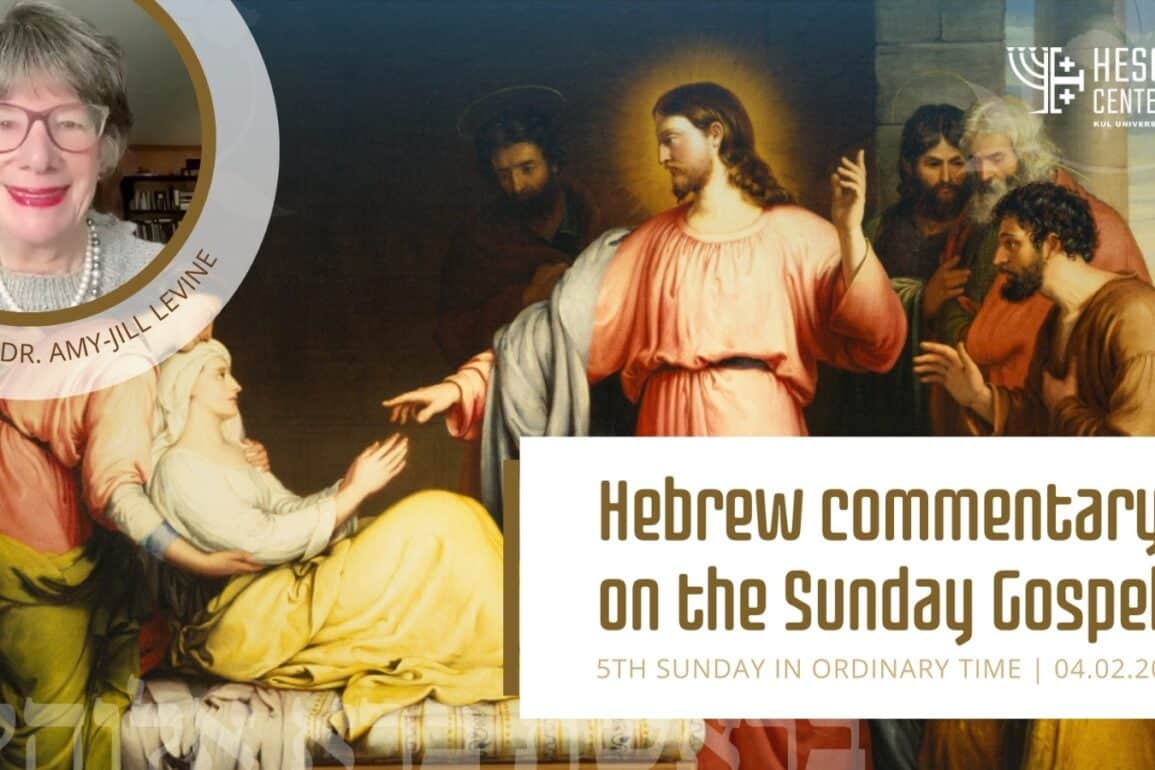Listening to the story of the healing of Simon Peter’s mother-in-law, who rose from her her bed and “waited on” Jesus and his disciples, we can perceive it as a message to women to serve men always and everywhere, regardless of circumstances – about why this impression is misleading and what the story can be a call to, explains Dr. Amy-Jill Levine, professor of New Testament and Jewish Studies and the first Jewish woman to teach New Testament at the Pontifical Biblical Institute in Rome, in a commentary for the Catholic University’s Heschel Center for Sunday, February 4.
The reading from Job 7 begins: “Is not man’s life on earth a drudgery? … He is a slave who longs for the shade, a hireling who waits for his wages.” For Job the human condition is work without joy; drudgery without freedom. The reading from 1 Corinthians 9 reinforces this impression with its notice that Paul makes himself “a slave to all.” Thus, when we hear that when Jesus healed Simon Peter’s mother-in-law of a fever, she rose from her bed and “waited on” Jesus and his disciples, we see her as one enslaved, engaging in service with no joy, obligation with no freedom. The message, especially to women, threatens to become one of serving men, even if that service requires rising from a sickbed.
Both the translation of the text and the impression are misleading. First, Simon Peter’s mother-in-law does not simply “wait on” or “serve” Jesus. The Greek verb describing her action is diakoneo, meaning “to minister.” Mark uses the same word just a few verses earlier to describe how the angels ministered to Jesus in the wilderness. Indeed, in Mark 10.45, Jesus uses the same verb, diakoneo, to describes his own mission as “to minister.
Second, there is no reason to assume that Simon Peter’s mother-in-law ministered only to men. Mark 15.4 uses the same verb, diakoneo, to describe the women at the cross, who not only followed Jesus but also “ministered” to him when he was in Galilee. These women likely accompanied Jesus to Peter’s home. The mother-in-law may even have provided these other Galilean women a model.
Third, contrary to a number of sermons, by healing Peter’s mother-in-law, Jesus is not reaching out to the “marginal” or the “least” in society. While the first century was patriarchal, as is the twenty-first century, Mark shows us here that women were part of larger family systems, that they have access to their own resources, that they are not hidden behind screens or relegated to women’s quarters. Peter’s mother-in-law rather anticipates the women patrons of Luke 8.1-3, who also ministered (again, diakoneo) to the male and female followers of Jesus.
Fourth, the mother-in-law’s ministry is not simply about serving food or more broadly about hospitality; it includes spiritual comfort as the angels provided, financial support as the patrons in Luke 8 show, and teaching, as Phoebe the deacon in Romans 16 demonstrates.
Fifth, and most extraordinary, the Greek verb egeiro, “to raise,” which Mark uses to describe Jesus’s action in raising Peter’s mother-in-law, is the same word Mark uses to describe not only Jesus’s raising the paralyzed fellow, the daughter of Jairus, and the demon-possessed boy, but also, in 14.28 and 16.6, Jesus himself, whom G-d raised (egeiro) from the dead. Thus, Peter’s mother-in-law foreshadows not only the ministry of Jesus and his followers, but also Jesus’s own resurrection.
Rather than relegate Simon Peter’s mother-in-law’s role to one of drudgery or enslavement, we should celebrate her leadership in showing others how to act, in anticipating the office of deacon, and as foreshadowing Jesus’ own ministry and resurrection.
About the author:
Amy-Jill Levine is University Professor of New Testament and Jewish Studies Emerita and Mary Jane Werthan Professor of Jewish Studies Emerita at Vanderbilt University. She is also Rabbi Stanley M. Kessler Distinguished Professor of New Testament and Jewish Studies, Hartford International University for Religion and Peace. In the spring of 2019, she became the first Jew to teach a course on the New Testament at the Pontifical Biblical Institute in Rome; in 2021, she was elected a member of the American Academy of Arts and Sciences.










